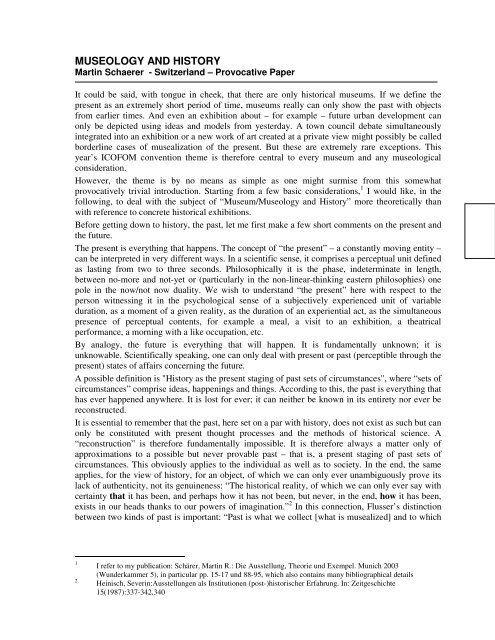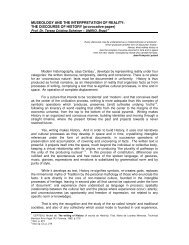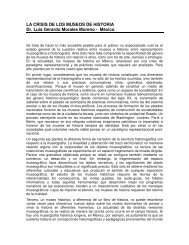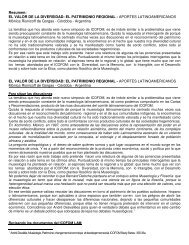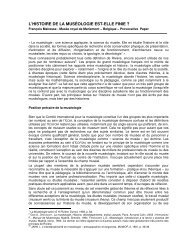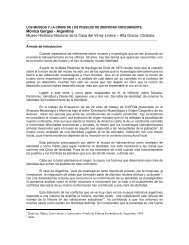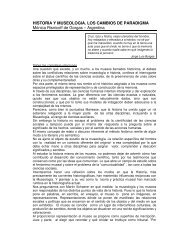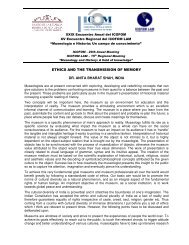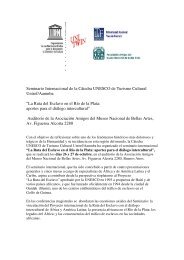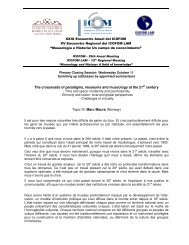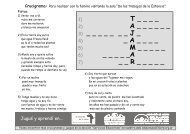MUSEOLOGY AND HISTORY
MUSEOLOGY AND HISTORY
MUSEOLOGY AND HISTORY
Create successful ePaper yourself
Turn your PDF publications into a flip-book with our unique Google optimized e-Paper software.
<strong>MUSEOLOGY</strong> <strong>AND</strong> <strong>HISTORY</strong><br />
Martin Schaerer - Switzerland – Provocative Paper<br />
It could be said, with tongue in cheek, that there are only historical museums. If we define the<br />
present as an extremely short period of time, museums really can only show the past with objects<br />
from earlier times. And even an exhibition about – for example – future urban development can<br />
only be depicted using ideas and models from yesterday. A town council debate simultaneously<br />
integrated into an exhibition or a new work of art created at a private view might possibly be called<br />
borderline cases of musealization of the present. But these are extremely rare exceptions. This<br />
year’s ICOFOM convention theme is therefore central to every museum and any museological<br />
consideration.<br />
However, the theme is by no means as simple as one might surmise from this somewhat<br />
provocatively trivial introduction. Starting from a few basic considerations, 1 I would like, in the<br />
following, to deal with the subject of “Museum/Museology and History” more theoretically than<br />
with reference to concrete historical exhibitions.<br />
Before getting down to history, the past, let me first make a few short comments on the present and<br />
the future.<br />
The present is everything that happens. The concept of “the present” – a constantly moving entity –<br />
can be interpreted in very different ways. In a scientific sense, it comprises a perceptual unit defined<br />
as lasting from two to three seconds. Philosophically it is the phase, indeterminate in length,<br />
between no-more and not-yet or (particularly in the non-linear-thinking eastern philosophies) one<br />
pole in the now/not now duality. We wish to understand “the present” here with respect to the<br />
person witnessing it in the psychological sense of a subjectively experienced unit of variable<br />
duration, as a moment of a given reality, as the duration of an experiential act, as the simultaneous<br />
presence of perceptual contents, for example a meal, a visit to an exhibition, a theatrical<br />
performance, a morning with a like occupation, etc.<br />
By analogy, the future is everything that will happen. It is fundamentally unknown; it is<br />
unknowable. Scientifically speaking, one can only deal with present or past (perceptible through the<br />
present) states of affairs concerning the future.<br />
A possible definition is "History as the present staging of past sets of circumstances", where “sets of<br />
circumstances” comprise ideas, happenings and things. According to this, the past is everything that<br />
has ever happened anywhere. It is lost for ever; it can neither be known in its entirety nor ever be<br />
reconstructed.<br />
It is essential to remember that the past, here set on a par with history, does not exist as such but can<br />
only be constituted with present thought processes and the methods of historical science. A<br />
“reconstruction” is therefore fundamentally impossible. It is therefore always a matter only of<br />
approximations to a possible but never provable past – that is, a present staging of past sets of<br />
circumstances. This obviously applies to the individual as well as to society. In the end, the same<br />
applies, for the view of history, for an object, of which we can only ever unambiguously prove its<br />
lack of authenticity, not its genuineness: “The historical reality, of which we can only ever say with<br />
certainty that it has been, and perhaps how it has not been, but never, in the end, how it has been,<br />
exists in our heads thanks to our powers of imagination.” 2 In this connection, Flusser’s distinction<br />
between two kinds of past is important: “Past is what we collect [what is musealized] and to which<br />
1<br />
2<br />
I refer to my publication: Schärer, Martin R.: Die Ausstellung, Theorie und Exempel. Munich 2003<br />
(Wunderkammer 5), in particular pp. 15-17 und 88-95, which also contains many bibliographical details<br />
Heinisch, Severin:Ausstellungen als Institutionen (post-)historischer Erfahrung. In: Zeitgeschichte<br />
15(1987):337-342,340
we can have recourse under certain circumstances, our memory, and past is what we forget and<br />
what can in certain circumstances can come to us again, so to speak backwards [e.g. garbage].” 3<br />
As an abstract construct, as an idea, then, “history” may not be musealizable (this is only possible<br />
with its materialized remains, such as objects, pictures, books, films, etc.), but it most definitely can<br />
be visualized in an exhibition – above all with things as signs referring to past sets of<br />
circumstances. The same goes for “nature”. Thus, man always has only an incomplete and<br />
provisional notion of past sets of circumstances, a notion which moreover is changing all the time.<br />
It rests on things which have been passed on: stories, documents, objects. According to this, there is<br />
not one definitive, assured, objective historical truth, only provisional statements. Views of history<br />
are therefore always fictitious, which however does not rule out a very high degree of probability.<br />
Particularly in everyday history, the fictionality frequently exists in the fact that although it can be<br />
approximately stated how certain social strata, occupations etc. lived, such knowledge can generally<br />
not be associated with individual persons. Ths sum of all knowledge about the past represents an<br />
increasing approximation to a probable view of history. It can never be known about one person<br />
alone, and hence exists only potentially as part of collective knowledge.<br />
One of the main reasons why such recognized facts are hard to accept lies in the circumstance that<br />
museums, which basically enjoy a very high visitor credibility rating because of the original object<br />
(“objective time witnesses” as “evidence”) – as institutions, because exhibitions are rarely<br />
prominently associated with authors. If the exhibited objects are authentic, the story recounted in<br />
connection with them must also be true! But it is precisely here that chance and subjectivity in the<br />
choice of objects must again be pointed out. “Historicality” Steen writes, “is not a characteristic of<br />
things as such, but perception and interpretation A characteristic is the authentic thing, the attested<br />
origin from a world prior to today’s world… As exhibits, the objects require a means of<br />
presentation if they are to be exhibits at all. As mundane as that may sound, it is true of every<br />
exhibition.” 4<br />
This brings us back to the artificiality of the exhibition situation. Maure puts it lilke this: “In the real<br />
world, objects do not exist in isolation. An isolated object is a hypothetical construction.” 5 “To<br />
isolate an object from any physical or social connection and ask what it means, is as meaningless or<br />
reductionist as isolating a word in a sentence.” 6<br />
The objects obtained by musealization scarcely provide any information about the original reality.<br />
This can only be explained subjectively and with time constraints by current knowledge against the<br />
background of socially and individually accumulated findings. An essential reason for this lies in<br />
the fact that, thanks to their physical durability, things often outlive the meaning systems of their<br />
first life. Information which we can apply usually comes only from the meaning-world and sign<br />
systems of our time. An exception could however be postulated with respect to oral information<br />
provided by people who lived with these objects. But the object itself is always mute. The title of<br />
one essay puts it this way: Le mythe de l'objet ventriloque (The myth of the ventriloquial object). 7<br />
The object requires explanation precisely because it has been musealized and is therefore<br />
“accessible” as it is therefore no longer in its original individual-unique space/time context.<br />
Precisely because, in the end, a museum musealizes not only things but also man–thing<br />
relationships (attributed values, hence “information” in the broadest sense 8 ) it cannot simply put<br />
across objects, but also only values, in a certain sense also myths about the past. The fact that any<br />
3<br />
4<br />
5<br />
6<br />
7<br />
8<br />
Flusser, Vilém: Dinge und Undinge. Phänomenologische Skizzen. Munich 1993:19<br />
Steen, Jürgen (Hg.): Zur Struktur der Dauerausstellung stadt- und heimatgeschichtlicher Museen. Frankfurt<br />
1998:6<br />
Maure, Marc: The exhibition as theatre. On the staging of museum objects. In: Nordisk Museologi 2(1995):159<br />
Ebd. 160<br />
Clément, Bernard: Le mythe de l’objet ventriloque. In: Guigue 1983:37-40<br />
This is the immaterial side of things; however, we do not intend to go further into intangible heritage here<br />
2
historical representation is, in the end, an interpretation, means that false interpretations are also<br />
possible in exhibitions.<br />
It may therefore be important in an exhibition to also provide pointers to the exhibition language<br />
used, i.e. to make the chosen representation intelligible (with a kind of reading aid). Certainly, such<br />
immanent clues can be perceived by the practised view of any exhibition, but they are not<br />
immediately detectable for the average visitor, at the most perhaps on an emotional, atmospheric<br />
level. Relevant explicit pointers are useful in the didactic exhibition language, and highly desirable<br />
in the associative language. In this connection, Cameron demands that the visitors’ reading be<br />
understood by feed-back and that they be taught the exhibition code: “The first task in museum<br />
education is to teach the individual the language of the museum so that he can use the museum to<br />
fullest advantage.” 9 Such a meta-language also serves to relativize the statements made in order to<br />
partially remove from an original auratic object pretending to a real reality this very reality<br />
reference, to say that a real object and a museum-piece are not identical, that an object always also<br />
has a semiotic and an anecdotal character, finally to point out that an exhibition can only show not a<br />
direct but only a transposed reality. This prevents the “visitor to an exhibition from being immersed<br />
in an apparent reality.” 10 Or, to put it another way: “the pathos of historical truth should be replaced<br />
by the irony of broken views of history”. 11<br />
This can be communicated in very different ways, for instance by a declaration of intent in an<br />
introductory text or by means of alienating representations which create a critical distance between<br />
the visitor and the exhibition (which is naturally easiest in the associative exhibition language<br />
already containing such elements ), in addition by guided tours and educative programmes. It can be<br />
argued that such thematization of the exhibition medium gains even more significance in a very<br />
time of increasing aestheticization and staging of everyday life. 12<br />
False positionings are also possible for a completely different reason. At the centre of every process<br />
of musealization is the reducing selection of things. Of necessity, the museum with its collections is<br />
therefore forced to construct a whole out of fragments, which naturally always also represents a<br />
political decision. “Fragmentation” writes Steen, “is a prerequisite of musealization. The object is<br />
the scientifically systematized fragment.” 13<br />
Institutionalized musealization in a museum therefore concerns only part of the musealized objects,<br />
which in their turn only represent a vanishingly small part of all things that have ever existed. With<br />
respect to museum collections, the problem of choice and the associated responsibility is extremely<br />
important: what thing is seen as an (important, typical ) document for a given area Selection in<br />
the museum follows socially defined criteria. Any collection policy, however it is defined, is always<br />
the time-dependent expression of prevailing scientific and aesthetic criteria. However neutrally it is<br />
formulated, adducing and specifying , for example, collection by whatever thematic and/or<br />
geographical criteria – authentic, exemplary, typical, representative, elementary, fundamental,<br />
innovative or model-based – the selection process, by which history is made, always features an<br />
eminently culture-fixing but also falsifying and hence dangerous element, which is at the same time<br />
endangered (because susceptible to manipulation.<br />
The resultant position of power of the museum should not be underestimated especially because –<br />
unlike in academia – the world views are anonymous and are presented in a context which lends<br />
9<br />
10<br />
11<br />
12<br />
13<br />
Cameron, Duncan F.: A Viewpoint: The museum as a communication system and implications for museum<br />
education. In: Curator 11(1968):39<br />
Grütter, Heinrich Theodor: Geschichte sehen lernen. Zur Präsentation und Rezeption historischer Ausstellungen.<br />
In: Erber-Groiss, Margarete (u.a. Hg.): Kult und Kultur des Ausstellens. Wien 1992:178-188,183<br />
Heinisch, Severin: Ausstellungen als Institutionen (post-)historischer Erfahrung. In: Zeitgeschichte<br />
15(1987):337-342,342<br />
Schärer, Martin R.: Museologie ausstellen. In: Fayet, Roger (Hg.): Im Land der Dinge. Museologische<br />
Erkundungen. Baden 2005:33-43 (Interdisziplinäre Schriftenreihe des Museums zu Allerheiligen Schaffhausen<br />
1)<br />
Steen, Jürgen: Kategorien der Darstellung von Geschichte im Museum. In: Museumskunde 60(1995):24<br />
3
authority. In addition, and much more so in non-pluralistic systems, there is the risk of the museum<br />
being misused for extraneous purposes which are incompatible with its tasks. Let us just think of<br />
the hijacking of history under national socialism and communism. And the anecdote that puts into<br />
the mouth of the leader of a new African country the statement that he needs – in this order – a<br />
powerful army, a functioning radio station and a national museum is, if perhaps not true, at any rate<br />
a very telling invention. Also, in times of political disorder, national history museums are rarely<br />
occupied, although they are often closed and later remodelled. Finally, the wars of succession in the<br />
former Yugoslavia with their deliberate destruction of national heritage sites are an extremely<br />
distressing spectacle. Regrettably, such subjects are rarely thematized (in terms of exhibitions).<br />
Ethical principles demand responsibility-conscious attention to the past. Museums are part of the<br />
collective memory and are hence also partly responsible for transmitted views of history. There is<br />
not one correct, so-to-say official version of history, but many different interpretations. What<br />
national, regional or local history museum dares to show them “The victor writes history” is<br />
unfortunately still the rule. And, it might of course be added: the person who pays! Still, there are<br />
some welcome tendencies, above all in temporary exhibitions, to portray the dark sides of the past.<br />
But even with good will, such an undertaking can founder on the simple fact that there are no<br />
objects left. After a (political) upheaval, nobody wanted anything more to do with the hated past<br />
and literally threw it out.<br />
Let me cite two striking examples to the contrary in the great context of the fall of communism. In<br />
many cities, statues of Lenin and Stalin were pulled down as superfluous and usually discarded. But<br />
luckily, not everywhere! In Narva (Estonia) Lenin was taken out of the city directly to the<br />
Hermanns-Feste on the eponymous border river (in other words right on the new external boundary<br />
of the European Union), not without a certain irony gazing eastwards with raised fist. And in Cēsis<br />
(Latvia), site of an old German city, Lenin was taken from the main square to a boarded-off<br />
partition in the Order castle where he can now be viewed – recumbent – as in an open grave. Next<br />
to it is a panel with photographs documenting the transportation. Here, an unloved past is not<br />
simply thrown out but is exhibited at a critical distance and without fear of history.<br />
In connection with the portrayal of history – both glorified and unloved – the question of<br />
representativity arises. Are the national heroes celebrated in museums really so heroic for the entire<br />
population Does everyone really want to forget the withheld past I plead for a history museum<br />
that gathers together and documents all witnesses of the past. And if the time is not yet ripe for the<br />
portrayal of the dark sides as well, the objects are available for future, less freighted generations.<br />
Historical exhibitions should strive to be as objective as possible in portraying the periods dealt<br />
with – while not forgetting that objectivity is impossible for the reasons mentioned earlier.<br />
Precisely because history is always a construct of the present, diverse and relativizing portrayals of<br />
the past are to be desired. It seems to me absolutely necessary to get away from the absolute,<br />
lecturing attitude – in “safe” exhibition themes as well as controversial subjects. How many<br />
European museums, for instance, show Roman times in an uncritical, affirmative and absolute<br />
manner! Our town in Roman times, that’s exactly what it was like, no ifs and buts! Does the<br />
museum lose credibility if we say that the present view of history has a high degree of probability<br />
on the basis of the known objects, the written documents and, naturally, the stringent application of<br />
methods of historical science Or if it also shows a different interpretation in an exhibition that is<br />
just as well founded<br />
“Relativization” seems to me to be a key concept here. The Alimentarium Food Museum in Vevey<br />
(Switzerland) attempted this with respect to the representational possibilities of the exhibition<br />
medium and using different exhibition languages in 1991. That year, the Swiss Confederation<br />
celebrated its 700th anniversary. For politicians it was a major, identity-backing event; for<br />
historians more of an opportunity for a critical appraisal. In line with the museum theme, seven<br />
small exhibitions were presented at the same time, each of which dealt with the object in a different<br />
way and all of which claimed to portray the history of food and nutrition since the Middle Ages.<br />
4
However, portrayal of the past was thereby relativized. 14 An example also presented the<br />
aestheticization of history, i.e. its reduction to a few “beautiful” objects. Such a presentation of<br />
utilitarian objects as objets d’art which, when all’s said and done, is ahistorical, because out of<br />
space and of out of time, makes any critical discussion of the past impossible. Another production<br />
showed a large collection of food objects from 700 years without any explanation, thereby allowing<br />
visitors to experience the mute object.<br />
A historical exhibition should also take local, regional and global interrelationships into greater<br />
account. Our Town in the Middle Ages, yes, but what was happening elsewhere at that time In<br />
addition, it is important to bring ethnic, religious and social minorities into the picture. So, once<br />
again, not only the glorification of “state-supportive strata” but at least an attempt at a holistic<br />
portrayal.<br />
Much is also made of the role of history in so-called postmodernism. I prefer the term “second<br />
modernism” 15 although it too fails to bring out the distinctness of an era. Beier interprets the<br />
growing attraction of history within the framework of second modernism (with the central elements<br />
of globalization, individualization and the shrinking importance of scientific knowledge) and with<br />
respect to three central functions of an exhibition: orientation, integration and edutainment. The<br />
growing interest in history in the last few decades is a very positive factor. There are many exciting<br />
theories about the reasons for this, which we cannot go into here. Let us simply mention the<br />
connection with an increasing lack of orientation in a very rapidly changing world. 16 Museums<br />
ought to turn this tendency to much greater advantage.<br />
The climate for historical exhibitions is excellent. But it also makes great demands on authors and<br />
expographers. We must never lose sight of the fact that exhibitions help to shape a view of history,<br />
which includes a large measure of responsibility for the museum. This statement gains a dual<br />
significance against the backdrop of the relativity of historical knowledge and the fictionality of any<br />
exhibition.<br />
14<br />
15<br />
16<br />
Schärer, Martin R.: 700 Years of Food. Or the 7 Exhibition Displays. Food in Switzerland from the late Middle<br />
Ages to the present day and ways of depicting the history of food in a museum. Exhibition in the Alimentarium<br />
Vevey 1991. An ICOFOM colloquium on the theme of exhibition language was also held in conjunction with<br />
this exhibition: ICOFOM Study Series 19 und 20<br />
Beier-de Haan, Rosmarie: Erinnerte Geschichte – Inszenierte Geschichte. Ausstellungen und Museen in der<br />
Zweiten Moderne. Frankfurt 2005<br />
See for example the important essay: Lübbe, Hermann: Der Fortschritt und das Museum. In: Auer Auer,<br />
Hermann (Hg.): Bewahren und Ausstellen. Die Forderung des kulturellen Erbes im Museum. ICOM-Symposium<br />
Lindau 1982. Munich 1984:227-246<br />
5


